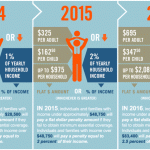
Is a Health Savings Account Right for you?
One key decision when selecting a health insurance plan is whether to couple it with a Health Savings Account (HSA). In today’s market, health insurance plans are passing on a larger share of costs to consumers (more high deductible health plans available for purchase). HSAs were created in 2003 so individuals covered by these high deductible plans could receive tax-preferred treatment of money saved for qualified medical expenses. HSA enrollments have grown 15% per year since 2011, and in 2014, 17.4 million Americans had enrolled in HSAs. This represents 6.2% of the total insured population of 280 million people.
Money put into an HSA can only be used for eligible medical expenses (i.e. dental, vision and medical, IRS Publication 502: http://www.irs.gov/pub/irs-pdf/p502.pdf), and because of this, that money is not taxed. As of 2015-2016, individuals can contribute up to $3,350/year, tax-free to the account. HSAs represent an intelligent investment option, particularly for people who know they’ll have large medical expenses in a given year (i.e. have a chronic illness or plan to become pregnant). But, HSAs aren’t only a vehicle for reducing taxes in a given year — money invested in a HSA can grow over time as a secondary retirement benefit. Accumulated HSA balances can be spent on care as you age, such as premium payments on certain Medicare supplemental plans once you’re over 65 and roll-over year to year.
Qualifying for an HSA under the HDHP (High Deductible Health Plan)
There is a big caveat to enrolling in an HSA – the health care plan a consumer chooses has to qualify as a High Deductible Health Plan (HDHP). For 2015, a plan qualifies as a HDHP if the individual deductible is more than $1,300 and the individual out-of-pocket maximum (OOP max) is less than $6,450.
Note: As with all ACA compliant plans, all preventative/wellness services are covered at 100%, no copay or deductible. Please refer to the preventative blog post as well as the network post to better understand the provisions and regulations.
If you don’t know what an HSA, or “health savings account” is, don’t stress. An HSA is really just a bank account you create to set pre-tax money aside for your health, dental and vision expenses. This account can be a simple checking account OR an investment vehicle (like the mutual funds you might use for your 401(k) money). Most banks can help your create one quickly. Typically banks have a monthly fee ($3.50), however partnering with Trek Insurance Group, LLC this account is free.
HSA’s are paired with high-deductible health plans (HDHP), which have lower monthly premiums. Because these payments are lower than those of a traditional plan, you pay more for medical services; ideally, you’re saving money in an HSA to cover those medical costs to off-set the increased cost when utilizing the plan.
Contributions to an HSA are tax-deductible if you are enrolled in a high-deductible health plan. The IRS has certain regulations on a minimum deductible in order to be considered a high deductible health plan. Below is a helpful chart for 2015 and 2016 plan years which demonstrates contribution limits, H.S.A. catch-up contribution (>55 years or older), HDHP minimum deductible, and HDHP out of pocket limits:
| Type of limit | 2015 | 2016 | Change | |
| H.S.A. Contribution Limit | Self-Only | $3,350 | $3,350 | No Change |
| Family | $6,650 | $6,750 | Up $100 | |
| H.S.A. Catch-up Contribution | Age 55 or older | $1,000 | $1,000 | No Change |
| HDHP Minimum Deducible | Self-Only | $1,300 | $1,300 | No Change |
| Family | $2,600 | $2,600 | No Change | |
| HDHP Maximum Out-of-pocket limits | Self-Only | $6,450 | $6,550 | Up $100 |
| Family | $12,900 | $13,100 | Up $200 | |
Thankfully, the IRS decided to release these dollar limits with ample time for businesses and individuals to prepare for open enrollment for the 2016 plan year. If you are an employer and do not offer a qualified health plan, then employees with family coverage (in the 39.6% marginal tax bracket) are being forced to pay an additional $2,673 year. Interest you earn on the HSA account is also tax free. You can keep your HSA funds even if you change health plans next year, never lose it like flexible spending accounts or FSA’s.
Bottom line: if you pay the medical expenses out of your HSA, you’re not taxed on the income you or your employer contributes.
What To Do With Your HSA
Once the money is in your HSA, you can spend it on any qualified medical expenses like doctor copays, prescription drug costs, knee braces, and many other similar expenses (read about all of them at: http://www.irs.gov/pub/irs-pdf/p502.pdf). If you contribute $2000, you’d keep at least $300 more to spend on your medical expenses that you’d otherwise pay to the IRS. Trek example: If you make $42,000 per year and contribute $2000 into your HSA, you will only be taxed on the net, $40,000.
81% of employers offer such a plan as an option in 2015 and one-third provide a high deductible health plan as the only option, according to the National Business Group on Health. Trek Insurance Group, LLC specializes in helping you stay compliant, and have a strong strategy moving forward, especially with the countless regulations coming into play over the next several years. We keep our members best interests at the center of everything we do!
Still have questions or if a Health Savings Account is right for you? Contact me at Info@TrekInsuranceGroup.com or call 602.859.1377





